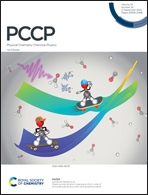The protein-stabilizing effects of TMAO in aqueous and non-aqueous conditions†
Abstract
We present a new water-dependent molecular mechanism for the widely-used protein stabilizing osmolyte, trimethylamine N-oxide (TMAO), whose mode of action has remained controversial. Classical interpretations, such as osmolyte exclusion from the vicinity of protein, cannot adequately explain the behavior of this osmolyte and were challenged by recent data showing the direct interactions of TMAO with proteins, mainly via hydrophobic binding. Solvent effect theories also fail to propose a straightforward mechanism. To explore the role of water and the hydrophobic association, we disabled osmolyte–protein hydrophobic interactions by replacing water with hexane and using lipase enzyme as an anhydrous-stable protein. Biocatalysis experiments showed that under this non-aqueous condition, TMAO does not act as a stabilizer, but strongly deactivates the enzyme. Molecular dynamics (MD) simulations reveal that TMAO accumulates near the enzyme and makes many hydrogen bonds with it, like denaturing osmolytes. Some TMAO molecules even reach the active site and interact strongly with the catalystic traid. In aqueous solvent, the enzyme functions well: the extent of TMAO interactions is reduced and can be divided into both polar and non-polar terms. Structural analysis shows that in water, some TMAO molecules bind to the enzyme surface like a surfactant. We show that these interactions limit water–protein hydrogen bonds and unfavorable water–hydrophobic surface contacts. Moreover, a more hydrophobic environment is formed in the solvation layer, which reduces water dynamics and subsequently, rigidifies the backbone in aqueous solution. We show that osmolyte amphiphilicity and protein surface heterogeneity can address the weaknesses of exclusion and solvent effect theories about the TMAO mechanism.



 Please wait while we load your content...
Please wait while we load your content...